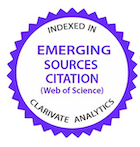Origem e distribuição antimérica dos nervos obturatórios em coelhos Nova Zelândia
DOI:
https://doi.org/10.1590/1089-6891v20e-55428Resumo
Coelhos da raça Nova Zelândia são amplamente usados como modelos experimentais e representam uma parcela importante dos atendimentos em consultórios veterinários. A conformação músculo-esquelética dos coelhos torna frequente a ocorrência de lesões lombossacrais com comprometimento neural. Visando contribuir para a anatomia comparada e no entendimento destas lesões, foram estudadas por dissecção a origem e a distribuição dos nervos obturatórios de 30 cadáveres de coelhos da raça Nova Zelândia (15 machos e 15 fêmeas) fixados previamente em formaldeído a 10%. O nervo obturatório formou-se a partir dos ramos ventrais de L6 e L7 em 63,3% dos casos, de L5 e L6 em 13,4%, apenas de L7 em 13,4%, de L7 e S1 em 6,6% e de L6, L7 e S1 em 3,3%. O segmento espinhal que mais contribuiu para a formação do nervo foi L7 (86,6% dos nervos). Os nervos obturatórios emitiram em todos os animais, número variável de ramos para os músculos obturador interno, obturador externo, pectíneo, adutor e grácil. Não foram observadas diferenças significativas entre as frequências da origem e de ramos musculares dos nervos obturatórios quando comparados sexo e antímeros.
Palavras-chave: anatomia animal, lagomorfos, Oryctolagus cuniculus, plexo lombossacral, sistema nervoso.
Downloads
Downloads
Publicado
Como Citar
Edição
Seção
Licença
Copyright (c) 2019 Ciência Animal Brasileira

Este trabalho está licenciado sob uma licença Creative Commons Attribution 4.0 International License.
Autores que publicam nesta revista concordam com os seguintes termos:
- Autores mantém os direitos autorais e concedem à revista o direito de primeira publicação, com o trabalho simultaneamente licenciado sob a Licença Creative Commons Attribution que permite o compartilhamento do trabalho com reconhecimento da autoria e publicação inicial nesta revista.
- Autores têm autorização para assumir contratos adicionais separadamente, para distribuição não-exclusiva da versão do trabalho publicada nesta revista (ex.: publicar em repositório institucional ou como capítulo de livro), com reconhecimento de autoria e publicação inicial nesta revista.
- Autores têm permissão e são estimulados a publicar e distribuir seu trabalho online (ex.: em repositórios institucionais ou na sua página pessoal) a qualquer ponto antes ou durante o processo editorial, já que isso pode gerar alterações produtivas, bem como aumentar o impacto e a citação do trabalho publicado (Veja O Efeito do Acesso Livre).






























